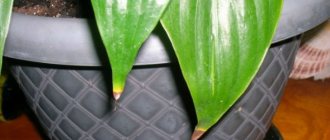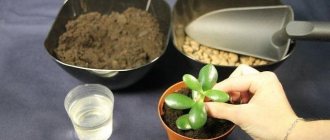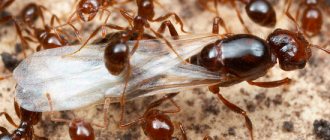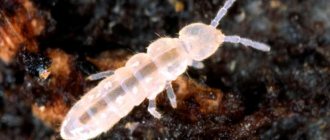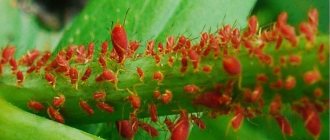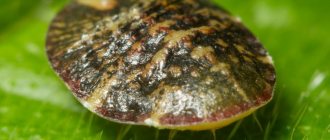When growing indoor plants - flowers, ornamental trees, exotic fruits - sometimes white spots appear on the surface of the soil or on the pots themselves. They can be barely noticeable or cover the soil with a dense cover.
It is necessary to understand the reason for the appearance of white plaque and determine methods to eliminate the problem.
- 5.1 Folk remedies
Reasons for the appearance of white plaque on the ground in flower pots
There may be several reasons why the soil in a pot becomes covered with a white coating. It should immediately be noted that failure to follow the rules of care, especially watering, is a source of problems with the well-being and appearance of indoor plants.
Among the most common reasons why the soil is covered with a white film are the following.
- Incorrect watering, as mentioned above. Alternating drying out and excessive moisture, or frequent watering with a meager amount of water, in which only the top layer of soil becomes wet, and the roots remain dry.
- Too high or low humidity , especially in combination with fluctuations in room temperature.
- Unsuitable container for the plant. In a pot that is too small, as well as in a pot that is too large, the root system does not develop properly and cannot absorb the required amount of nutrients and minerals.
- Stagnation of water in a pot (due to lack of drainage) or in a tray can also cause white deposits to appear.
Preventive measures
Using these tips, you can avoid the appearance of a white coating on the surface of the soil in flower pots:
Be more careful about watering. Do not start a new one while the top layer of soil is still wet from previous watering. Otherwise, you will simply oversaturate the soil with water and it will begin to stagnate. All this will lead to negative consequences for the flower;
Provide your plant with good drainage. To do this, the pot must have special holes at the bottom - this will help avoid stagnation of water in the container. Otherwise, it will lead to the appearance of fungus and mold. Also, before laying the soil, it is necessary to put a layer of expanded clay on the bottom of the container;
- Do not forget to periodically loosen the soil in the pot. This will make it more permeable to air, making it easier for the plant to breathe;
- For preventive purposes, it is recommended to water the soil with a solution of potassium permanganate once a month. This is to disinfect the soil from manifestations of the fungus;
- Don’t forget to regularly ventilate the room where the plants are located;
- The soil for planting must be of high quality; it is better to buy it ready-made in the store. But pay attention to the composition and its main purpose - the soil for seedlings is not suitable for adult plants;
- Use expanded clay as mulch. If it is not there, then you can replace it with river sand, or, in extreme cases, charcoal.
Now you have found out the reason for the appearance of white plaque in flower pots. Most of these reasons are associated with incorrect agricultural techniques, this is especially typical for beginning gardeners.
Therefore, if you provide your flower with proper care and the required conditions, you can easily avoid the appearance of plaque on the ground in your pots. And you can grow a wonderful, beautiful, and most importantly healthy flower.
Currently reading:
- Choosing cucumbers for open ground according to your preferences
- Proper cultivation of Adenium succulent with your own hands
- Description of 12 types of late cabbage varieties for planting
- Three methods of propagating and replanting a dollar tree
Popular: Eight reasons for blackening of spathiphyllum leaves
Share the news on social networks
About the author: Lyudmila Vasilievna Nosikova
Agronomist of the state agricultural enterprise "Garovskoe" of the Khabarovsk region of the Khabarovsk Territory.
Types of deposits on the ground
Most often, white plaque on the ground in flower pots is:
- efflorescence on the ground;
- fungal diseases.
A thin layer of salt forms on the soil surface if there is an excess of minerals:
- in a large pot, the root system simply does not have time to “take” all the microelements from the ground, they appear on the surface with water;
- in case of an excess of microelements: for example, the soil for seedlings is additionally enriched with nutritional and chemical compounds. If you plant an adult plant in such soil that does not need such intensive feeding, the excess minerals will appear in the form of salts on the ground.
- if you get carried away with applying fertilizers, especially potassium ones, they are not absorbed by the plant and produce a salt deposit.
Fungal infections with a white coating:
- powdery mildew;
- mold fungus mucor;
- blue;
- black mold;
- actinomycetes are soil inhabitants that are both fungi and bacteria.
Fungal infection
In this case, the white color of the plaque is given by spores - microscopic “seeds” of fungi. Spores are easily carried by the wind, and can also be carried on the hands of the grower from other infected plants.
Very rarely, at home, a white coating on the soil can be caused by an invasion of aphids, which secrete a sticky substance - honeydew.
Why is mold dangerous for plants?
It is necessary to combat mold that appears on the ground immediately after detecting the first signs of damage. This fungus is very dangerous for plants and can lead to the following consequences:
- mold disrupts the process of plants absorbing nutrients;
- problems arise with the circulation of oxygen in the soil and, as a result, the roots of the plant suffer;
- fungus on the surface of the earth makes it difficult for moisture to evaporate and because of this, rotting of the root system begins;
- in advanced cases, the fungus can even lead to the complete death of the plant.
Mold on plants.
How to treat?
What to do to combat white plaque on the ground in pots will depend entirely on the cause of the whitening of the ground. Below we discuss options for getting rid of soil salinity.
Mulching with expanded clay
If you find white soil in flower pots, the top layer of soil should be removed and replaced with a layer of fine expanded clay. In addition to the mulching effect (to slow down the evaporation of moisture), it will also serve as a decorative design for the plant. Decorative pebbles, disinfected bark, and coarse quartz sand are also suitable for these purposes.
Soil waterlogging
When air humidity is more than 80% and constant high temperature (more than 25 ° C), the soil in indoor flowers can also turn white from the appearance of crystals of mineral salts. Accordingly, when these parameters are lowered, the problem disappears by itself.
Oversaturation with fertilizers
If there is an excess of mineral fertilizers in the soil for indoor plants, as mentioned above, they are not completely absorbed by the plant; some of them crystallize on the surface. The solution to the problem is to stop feeding. For an aesthetic effect, the top layer of soil from the pot can be removed and replaced with fresh one.
Oversaturation with fertilizers
The solution depends on the problem
Before taking action, you need to understand what mistake was made in caring for the flower. Hard water can be softened with citric acid in a proportion of 0.5 teaspoon per 1 liter of water. If the flower is planted in a pot that is too large, it should be replaced with a container of suitable capacity.
Purchased soil is often oversaturated with fertilizers, which also leads to the deposition of salts on the surface. In this case, the top layer of soil must be removed and a regular leaf substrate added instead.
Special preparations will help cope with fungal spores. It is necessary to treat the soil with foundationazole in a ratio of 2 g per 1 liter of water. If affected by rot, the flower must be transplanted into fresh soil treated with a fungicide.
It is recommended that all soil, even purchased in a store, be calcined before use. It is convenient to do this in a microwave oven.
It is useful to loosen the soil frequently to provide the roots with access to oxygen. If the soil is too heavy, then replanting into a loose substrate or partial replacement of the soil directly in the pot is necessary. It must have drainage holes.
Mold Control Products
Regardless of the type of harmful fungus that has settled in the pots, the principles of control will be the same.
Folk remedies
The means at hand will help get rid of the white coating on the soil at the early stage of mold infection, when the mycelium has not yet had time to grow into the deeper layers.
- Garlic has excellent fungicidal and disinfectant properties. You can dig a few peeled cloves into the soil or water the ground with infusion (pour 3 crushed cloves with a glass of boiling water, leave for a day).
- For plants that prefer acidic soils , watering with a solution of citric acid (no more than 3 g per 200 ml of water) can be recommended. This treatment should be carried out no more than 1-2 times a month.
- Ash, on the contrary, alkalizes the soil, improves its structure and oxygen saturation. Depending on the size of the pot, 1-5 tbsp. l. ash is added at the root and gently mixed with the top layer of soil.
Purchased funds
If the soil in flower pots turns white due to the development of pathogenic mold fungi, then changing the soil is no longer possible; folk remedies are not always effective. You will have to resort to the help of fungicidal drugs, which suppress the growth of microflora.
To get rid of mold in flower pots, the following chemical fungicidal preparations can be recommended.
- Azofoska is a domestic drug, an active ammonium-copper-phosphate compound. The working solution is prepared according to the instructions and sprayed on the plant and soil. The composition is also a foliar fertilizer for plants, providing the required amount of nitrogen compounds, copper, calcium, phosphorus, etc.
- Topsin M is a systemic fungicide, jointly developed by Japanese and German chemists. The active toxin is methyl thiophanate. Used for spraying and watering the soil under the plant.
- Sarfun 500 SC is a product manufactured in Poland. The active substance is carbendazim. Systemic highly effective fungicide, used for spraying, compatible with almost all chemicals.
Advice! To be sure to get rid of white mold deposits on the soil, carefully read the instructions for the drug, which describe how to prepare and use it (concentration, frequency of treatments, precautions, etc.).
Azofoska
Popular folk remedies
If the mold has appeared recently and the lesion is small, you can do without strong chemicals. So, to treat the soil, gardeners use a weak solution of citric acid: 2-3 grams per glass or just lemon juice (squeeze the lemon into a cup of water). The plant should be watered no more than twice a month. This product is suitable for flowers that can grow in acidic soil.
Sometimes ordinary garlic is used for disinfection. To do this, several cloves are buried near the plant or an infusion is made. When watered, garlic saturates the soil with phytoncides, which suppress the development of pathogenic bacteria.
Proper care will help get rid of mold.
Adding wood ash to the soil, treating with potassium permanganate, and spraying with a solution of dry mustard also has a positive effect.
Prevention
To prevent the appearance of white plaque in flower pots, you should adhere to simple rules of home gardening.
- It is necessary to ensure drainage in pots (plant pots). To do this, expanded clay, pebbles, and fine gravel are poured onto the bottom (about a quarter of the height of the container with the plant). Drainage is necessary to remove excess moisture from the roots.
- Optimal watering. It is necessary to water indoor plants when the soil dries to a depth of 3 cm. Wait until water begins to come out of the drainage holes. Sometimes, instead of watering, you can use spraying or deep loosening of the soil.
Advice! It is better to dry out the soil in the pot than to over-water it!
- The composition of the soil must be balanced for a particular plant. In general, we can say that indoor flowers love loose, low-fat substrates, so adding sand, vermiculite, etc. to the soil mixture will not be superfluous.
- You should not get too carried away with mineral fertilizing, especially in the winter season , when the growth and development of the plant slows down and it requires less nutrients.
- To normalize the soil microflora , you can periodically (1-2 times a month) water it with a weak solution of potassium permanganate and/or water acidified with citric acid or lemon juice.
- Ultraviolet light is a panacea for many diseases. Regular sunbathing will help make the plant strong and immune to various ailments.
Prevention of soil against white plaque (mold)
Overcoming fungus in a flower pot is not always easy; it takes more than one day; sometimes even a week is not enough. Therefore, it is always easier to prevent infection than to treat it later.
Prevention measures:
- Constant loosening of the soil, especially after watering. This will provide additional air supply and evaporation of excess moisture.
- Providing good and reliable drainage. This is one of the main conditions for planting a flower. It is important that it allows water to pass through well.
- The correct selection of flowerpots or pots. Pots should be selected depending on the shape and location of the roots.
- Feed regularly. High-quality fertilizers will help the plant withstand stress.
- Monthly treatment with a weak solution of potassium manganese. Potassium permanganate will disinfect the soil.
- Ventilation of premises. Plants need daily ventilation of the room, but this does not mean that drafts need to be created.
- Creating an optimal humidity level.
By following simple and simple tips, you can prevent the appearance of white plaque and fungi such as mold.
Causes of mold, white or green deposits on the soil with seedlings and ways to eliminate them
Good afternoon, dear friends, gardeners and gardeners! Welcome to the website of the “Country Stories” channel.
1. Instead of an introduction.
During the period of growing seedlings, window sills, tables attached to them, shelves, racks - everything is lined with various boxes, containers, bowls, cups and other containers in which seedlings of tomatoes and peppers, eggplants, celery, petunias and other flowers grow green. But sometimes the earth itself turns green - mold grows on the surface of the soil. On top of this, quite often gardeners and gardeners notice how the soil under seedlings 2-3 weeks old is covered with plaque. This phenomenon causes a lot of concern, because we can talk about fungal infections or flaws associated with improper care.
https://vk.com/photo-159774511_457246705
2. What causes mold to grow?
Mold may appear as small white growths that may extend to the edge of the pot or concentrate on soil particles. Often white mold resembles a cobweb or moldy cap found on bread.
Typically, gardeners and gardeners who use organic substrates (coffee grounds, tea, plant residues, compost, mushroom-based preparations) encounter this problem. Under favorable conditions, organic matter will actively decompose with the formation of mold on the surface. This is an absolutely normal phenomenon that should not be feared. The same trichoderma, metarhizium or other beneficial fungi in the soil look like ordinary white mold.
If you notice a white coating on the ground, know that the soil is saturated with all kinds of saprotrophic microorganisms that feed on dead debris. Their rapid development does not pose any danger.
Fungi develop especially well in containers covered with polyethylene or glass. If the mold that appears on the surface bothers you in some way, you can simply sprinkle sand on top of it and limit watering. Once in less favorable conditions, mushrooms will stop their rapid growth.
How to distinguish fungal growths from mineral efflorescence?
Most often, mineral efflorescence appears when hard water is used for irrigation. Excess calcium salts begin to crystallize on the surface of the dishes used for growing seedlings. Taking into account the timing of plant growing, this phenomenon does not pose any danger.
If salt deposits are observed in pots with indoor plants that also cannot tolerate excess calcium, then you can prepare a special solution to solve this problem. A bucket of water will require 0.5 cups of vinegar (9%). The resulting solution should be poured generously into the pots with plants, so that excess moisture flows out through the drainage holes. Thanks to this treatment, it is possible to wash out most of the sedentary calcium salts. The procedure is repeated as necessary approximately every six months.
Why are green deposits dangerous?
Many gardeners use chlorella to maintain their plants. In this case, a greenish slimy mass can be seen on the soil surface. These algae are not dangerous, and the appearance of a green coating indicates that the plants have enough light and there is a lot of nutrients in the soil. If the soil is excessively waterlogged, the roots suffocate and the slimy masses may begin to bubble. In this case, it is advisable to limit the amount of water used for irrigation.
The appearance of moss on the soil surface is a serious wake-up call for gardeners. It indicates a nutritional imbalance. Moss grows in acidic soils with low nitrogen content. Sometimes this picture is observed when there is an excess of phosphorus fertilizers.
You can get rid of moss, which in itself is not harmful, with the help of corrective feeding. The best option is urea (1 tbsp per 10 liters of water), because in the initial phase of its effect, it alkalizes the soil.
2. Mold on the soil with seedlings. Main causes and preventive measures
Molds can form a white fluffy coating or a dense green layer even before germination. They also appear during the process of growing seedlings. It does not cause immediate harm, but if this point is left unattended and the conditions for growing seedlings are not changed, the results can be disastrous. After all, where there are molds, there are other pathogens.
What do mushrooms like? Humidity, even dampness. Cool. Acidic soil. Let's look at how the soil in which seedlings are grown can create favorable conditions for the development of fungi.
2.1. Increased humidity during germination.
Mold can appear on the soil surface even before seedlings emerge. The reason for this is too high humidity, because the seedling boxes are covered with a lid or plastic wrap.
It is for this reason that experienced gardeners recommend removing the cover every day, shaking off drops of condensation and providing an influx of fresh air.
2.2. Overflow.
Increased soil moisture can accompany plant growth throughout the entire period of growing seedlings if the gardener likes to water. Small plants simply do not have time to drink and evaporate so much water, so mold fungi multiply on the soil surface.
Do not overwater the seedlings. This is not good, even if there is no mold. After all, plant roots need oxygen no less than moisture and nutrition.
2.3. Water stagnation.
Poor drainage or its complete absence leads to stagnation of water at the bottom of the seedling box or pot. Despite the fact that experienced gardeners always emphasize the need to make large drainage holes, many continue to pierce holes with an awl or a thick needle. Such small holes quickly become clogged with soil, and excess water does not drain out. And where there is dampness, there is mold.
2.4. Cold.
Of course, fungi can multiply in warm soil, but most often mold occurs in boxes that stand on cool window sills. In addition, cold soil dries out more slowly, water remains in the soil longer, it turns sour, and here it is, mold. The soil temperature should be at least 18-20°C. If seedlings are grown on a windowsill, it is worth laying some kind of layer between the bottom of the boxes and the cold surface.
2.5. Lack of sun.
Soil and mold fungi do not tolerate bright sunlight. After all, in the sun the soil temperature rises and moisture evaporates, all this leads to their death. If you see white or green mold in your seedling pots, the seedlings may not be getting enough sun.
2.6. Acidic soil.
As you know, fungi multiply better in acidic soils, and bacteria grow better in alkaline soils. But even if we initially took ready-made peat soil with a neutral reaction to grow seedlings, then during the growing process, with the addition of mineral fertilizers, humic acids, and when watering with hard water, we can shift the soil reaction towards acidic.
2.7. Poor quality soil.
When using ready-made soils of good quality, mold occurs extremely rarely, because they do not contain spores of pathogenic microflora. But when growing seedlings in a soil mixture of your own production, consisting of garden or garden soil, such phenomena are not uncommon.
Therefore, it is extremely important to pre-steam the soil, as well as populate it with competitive microflora from beneficial soil bacteria and fungi. Containers that have already been used last year must be thoroughly washed and treated with bactericidal agents, vinegar, and soda.
3. What to do?
What to do if a coating of white or green mold appears in places on the surface of the soil?
3.1. Remove mold.
First of all, remove the mold layer mechanically using a sharp knife, spatula or any small garden tool. Unfortunately, this will not give an absolute effect, because... If a fungus appears on the surface, it means that it has already begun to grow inside the soil. And then after some time it will appear again, if the conditions do not change.
3.2. Dry the soil.
Try to dry the soil in some way. If the seedlings were covered with a lid, remove the lid. If the box is in a cool place, move it to a warmer place, place it closer to the sun's rays. Loosen the top layer of soil. Clear drain holes if they are clogged.
All these methods will help stop the development of pathogenic fungi. But in order to completely get rid of them, you will need something more serious, namely bacteria or fungi, which will fight the mold and gain the upper hand.
3.3. Treat with biofungicides.
Biologics are sold in liquid, powder, or tablet form. In our case, when the soil is already so waterlogged that mold has developed, additional moisture, even with a bacteriological preparation, is undesirable.
It is better to use dry preparations, for example, “Fitosporin M” in the form of a powder, which contains spores of the bacteria Bacillus subtilis or “Trichoderma Veride” with spores of the beneficial fungus Trichoderma.
Spilling the soil with a pink solution of potassium permanganate or hydrogen peroxide does not give the same effect as biological products, but in the absence of them, these agents can be used.
https://vk.com/photo-159774511_457246704
Thank you for your interest in my article.
What to do?
There are different ways to deal with this plaque. I think the easiest way is to remove the top layer and replace it with fresh soil. I add some river sand on top and mix it with the top ball of soil. I had to get rid of mold only by completely replanting the plant and pre-treating the pot with laundry soap and boiling water.
Well, how to prevent many other problems with indoor flowers, watch this video:
Marina Makarova
Operation Rescue
If there are single manifestations of mold on the soil, it is enough to stop watering, dry the plant and replace the surface layer of soil (2-3 cm) with fresh, calcined soil. Be sure to add “medicinal” charcoal or sphagnum moss, which will help absorb moisture. Pour in a solution of “Fundazol” (2 g of powder per 1 liter of water).
The longer mold remains on the soil, the deeper it goes.
In case of massive damage, you can get rid of mold in flower pots only by completely replacing the soil. To do this, remove the plant and set it aside to dry for a day. Rinse the container to remove any remaining soil, pour boiling water over it, and dry thoroughly. If the drainage holes are too small, enlarge them to prevent them from becoming clogged again.
On plastic pots, mold spores can survive and even after treatment with soil replacement begin to multiply again.
Place a drainage layer of pebbles or crushed bricks at the bottom. Before backfilling, new soil must be disinfected. Steam in a water bath, heat in a frying pan, in the oven, or pour over a solution of potassium permanganate. After planting a flower, pour a thin layer of sand on top or spread expanded clay, which will help draw in excess moisture.
Why the enemy does not sleep
Mold in flower pots appears in favorable conditions, namely:
- Frequent watering. The accumulation of water creates high humidity - an ideal environment for fungal growth.
Most often, the appearance of mold in flower pots can be observed in spring and autumn, when there is no heating, the room becomes cool and the soil in the deep layers dries out slowly. Ideal conditions for the development of fungal infections.
In summer, when humidity is high, midges appear above flower pots.
Why does the soil in the greenhouse turn white?
Many summer residents wonder why the soil in the greenhouse turns white, because they take such careful care of it, fertilize it, water it and weed it. So what is the cause of green soil, mold and white residue?
The most common causes are excessive soil moisture, pests and improper care.
The soil is sick for several reasons:
- If you water the soil endlessly.
- With increased soil acidity.
- When the greenhouse is poorly ventilated or absent at all, resulting in increased humidity in the room.
- If you add a lot of fertilizers to the soil.
These reasons can be combined with each other.
How to distinguish
Mold and efflorescence can be difficult to distinguish by sight, but simply by touch. Efflorescence is dry and hard to the touch, it is difficult to confuse it with mold: the organic matter is soft, slightly moist, alive. In both cases, the color does not have to be white. For example, the red color of efflorescence indicates that iron and magnesium salts predominate in the water; It appears white when there are a lot of insoluble calcium salts (lime) in the water.
This is why there is little efflorescence if you use soft or settled water. By the way, there is a lot of efflorescence in snow water with excess sodium salts. If you are confident in the quality of the water, and efflorescence appears, the cause may be insufficient drainage, overly fertilized soil, or incomplete wetting of the soil.
Source 1olestnice.ru
It is especially easy to distinguish a fungal infection from efflorescence. Mold looks like a downy coating, thin threads are visible; Over time, it grows along the walls of the greenhouse. Both mold and efflorescence should not be ignored. You need to take the fact especially seriously when the soil in the greenhouse turns yellow or green; what to do in this case depends on the time of discovery and the age of the plants.



